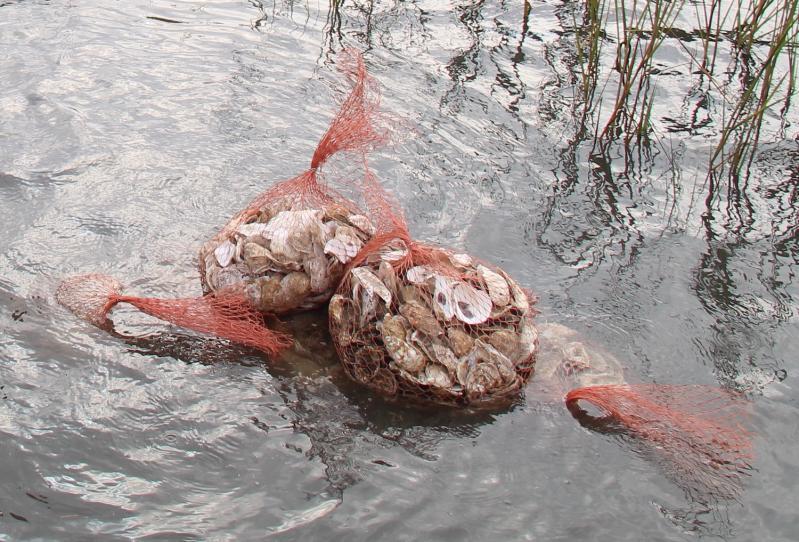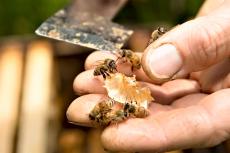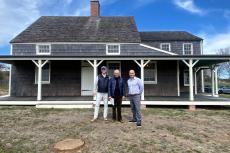During a presentation before the East Hampton Town Trustees, a researcher with Stony Brook University’s Gobler Lab said Monday that oyster survivorship in Georgica Pond is the highest the lab has ever seen in Long Island coastal waters.
The oyster spawns were placed in three locations in Georgica Pond several years ago: north, central, and south. In 2021, researchers terminated the north site because of difficulties getting out to the cages, owing to the muddiness of the area.
The end goal of the project is to “recruit” oysters, meaning to have juveniles join a population, and establish a place for them to spawn in the future without the involvement of scientists. While the research is yet inconclusive, the lab has developed a new molecular technique that can filter and process water samples, helping researchers in identifying oyster larvae.
“Recruitment is important,” said Michael Doall, the associate director of bivalve restoration and aquaculture for the lab. “The goal of this is to make this self-sustaining” and “the key to that is recruitment.” As of now, though, the lab has not seen enough of it.
Still, with the survivorship success at Georgica Pond, Mr. Doall proposed at the end of the presentation adding an additional spawn on the eastern edge of the pond, which would host 100 shell bags in two adjacent rows.
While the location would be exposed during low tide when the inlet is open, oysters are able to survive shifting tides, as long as the water remains at a moderate temperature. A homeowner along Briar Patch Road granted the researchers permission to access the site.
In Georgica, oyster survivorship over the past five years has floated between 40 and 50 percent, “which is really quite amazing,” Mr. Doall said. That number is the “highest oyster longevity we’ve seen.” Beyond that, the five-year-old oysters now measure about four inches long.
For comparison, the lab has been placing oysters in Shinnecock Bay for eight years. There, oysters planted in 2019 survive at a rate of 10 percent after three years, while that number is slightly higher for those planted in 2021. (Data for those oysters, however, account for only up to two years after planting.)
Dermo, a disease caused by the parasite Perkinsus marinus, is more prevalent in Shinnecock Bay oysters, causing a higher rate of die-offs. According to data from 2023, after five years, dermo is prevalent in more than 90 percent of oysters there. As time goes on, the severity of the disease also increases.
“You see this much, much higher survivorship in Georgica Pond,” Mr. Doall said, and the reason for the discrepancy is the lower salinity there, which offers those oysters refuge from the disease. For four-year-old oysters in the pond’s southern spawn, the prevalence of dermo was 0 percent, compared to well over 90 percent for those in Shinnecock Bay.
At the central location in Georgica, the number of oysters affected was just higher than 20 percent, though the intensity was again far lower than for the Shinnecock Bay spawns. According to a graph shown by Mr. Doall, the south spawn performs marginally better than the central spawn.
In the fall of 2022, researchers placed shell bags lined with spat at two sites. Since the spat were not placed in cages, they were vulnerable to predators, such as the blue crab, which is present in both Shinnecock Bay and Georgica Pond.
Two years later, there are “many” living oysters on the shell bags at both reefs. Despite evidence of predation in the form of scars, many oysters ultimately grew to a size that made them safe from predators, which takes about one year.
As for the shell bags themselves, the exterior is made of a biodegradable mesh, and each can hold five gallons of clean shells.
“We’ve been able to show that oysters have a really long life span in Georgica Pond; they can survive and grow” there, Mr. Doall concluded.
Sara Davison of the Friends of Georgica Pond Foundation took to the lectern to announce her support for the program: “I think you can get a sense of how thorough” the process has been, she said, before offering any assistance that the town trustees or the Gobler Lab might require.
Regardless, Jim Grimes, the deputy clerk of the trustees, said he would like to hear from the public before the trustees expand the project to the site on the eastern edge of the pond.
“This is the first time the public is hearing about this,” he said, adding, “I just want to make sure we act in a responsible manner in our stewardship of the pond.”
With that, the trustees tabled the discussion for one month to allow the public to offer comments.




